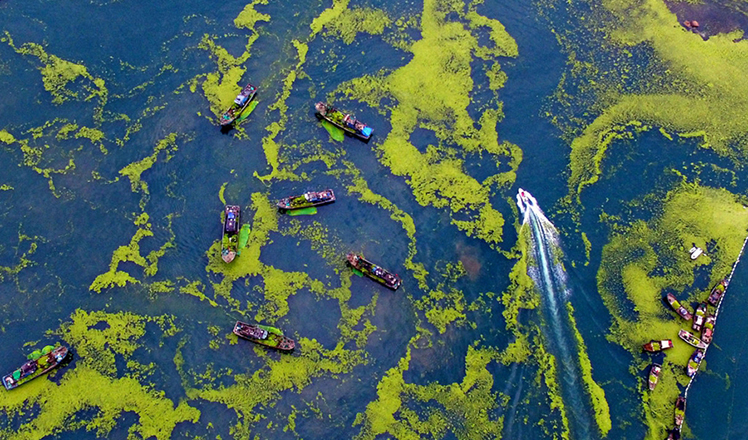Counting the costs of floods in China
Updated: 2016-07-18 11:00
By Asit K. Biswas and Cecilia Tortajada(chinadaily.com.cn)
|
||||||||
There is absolutely no doubt that had the Three Gorges and other dams not been constructed, flood damages in China during high rainfalls years, including this year, would have been significantly higher.
Paradoxically, in the Chinese social media, major dams have been accused of contributing to high flood damages. Nothing is further from truth. Well designed and managed, large dams invariably ameliorate floods damages. They do not add to them.
Storage dams, however, are not enough. When high rainfalls occur over the Chinese cities, they currently do not have adequate infrastructure to drain away excess waters. Cities have grown much faster than drainage works could be planned, executed and managed. Consequently, the number of cities that are seriously affected by floods has more than doubled during the past 7-8 years. At present, routinely more than 200 Chinese cities are waterlogged each year during each monsoon season.
Breakneck expansions of major cities, poor planning, endemic corruption and absence of good land use planning, have further exacerbated the problem.
Take Wuhan, capital of Hubei province at the confluence of Yangtze and Han rivers. It is historically known as the “city of 100 lakes”. However, it has lost more than 2/3rd of its lakes,from 127 to 40, during the period 1949-2015. Lakes and wetlands were filled to make way for construction projects. These lakes and wetlands used to store water during the flood years, reducing adverse impacts on the city. The 40 remaining lakes are not enough of a buffer to store flood waters. Furthermore, their storage capacities have been impaired by heavy sedimentation due to poor land use practices and construction activities.
Corruption and wasteful spending have further aggravated flood problems in China for decades. For example, Premier Zhu Rongji coined a phrase to describe a badly constructed crumbling dike in Jiujiang City in 1998 as a tofu-dregs and turtle egg project. Tofu dregs are pieces left over after making tofu.
The situation still has not improved that much. According to local media reports, the person responsible for the construction of 1 billion RMB drainage project in Wuhan was accused of accepting 1.6 million RMB bribes between 2005 and 2013.
Bad planning and shenanigans have ensured that Wuhan’s subway line built only four years ago was badly inundated. People’s Daily reported last month that Wuhan allocated RMB 13 billion, in 2013, for a three-year programme to improve its drainage. Only RMB 4 billion has been disbursed so far, and completion date has now been delayed to 2018.
National Development and Reform Commission noted on July 10 that fruits and vegetables prices in some flooded areas have “risen significantly”. They instructed local authorities to “closely monitor prices”. Flooding is likely to increase annual consumer prices by 0.2 percent, to over 2 percent. It would also have a negative impact on China´s GDP growth in the third quarter. Equally, construction and rebuilding activities may increase aggregate demand. Thus growth in the fourth quarter, after a weak July-August period, likely be higher.
Chinese leadership is well aware of the economic and social risks imposed by floods. Premier Li Keqiang has already noted, the “government is better prepared than ever”. It has taken several measures and is fully prepared againstpossible floods since July-August are “key periods for floods”. Similarly, President Xi Jinping has ordered array of measures to step up relief actions.
China has made considerable progress in recent decades to reduce fatalities due to floods. However, a new mindset is needed at all levels of decision-making, central, provincial and municipal. It has to be realized that improper developments can contribute to floods, and floods do affect development. Policy-makers need to realize that floods are both developmental issues and humanitarian concerns.
There are systemic problems that need to be overcome. Water bodies and wetlands in and around cities have been filled up for construction activities, thus have seriously disrupted natural drainage patterns. Lakes, as in Wuhan, have steadily been shrinking. Governments at provincial and municipal levels have mostly turned blind eyes to construction activities in flood-prone areas. Cities have not kept up with the construction and proper operation and maintenance of storm drainage systems. Dikes protecting the cities may be working but drainage systems in many cities are grossly inadequate.
Technically and economically, floods in China cannot be completely eliminated. However, their impacts can be significantly reduced by proper land use planning and flood management. For the Chinese leaders at all levels, floods are a challenge that needs to be overcome to deliver good living conditions for the society.
Finally, many poor decisions taken over the past 50 years on urban development cannot be eliminated overnight. It will take political will, time, money, and good holistic planning and implementation before flood damages in China can be significantly reduced.
Asit K. Biswas is Distinguished Visiting Professor at Lee Kuan Yew School of Public Policy, National University of Singapore; Cecilia Tortajada is Senior Research Fellow at the Institute of Water Policy, in the same School.
- 8-year-old boy gains 11kg to save father
- China rebuts claim it sank Vietnamese fishing boat
- China on high alert as floods kill 237
- What I want is a healthy grandson, so I will try anything I can
- China calls on US, Japan to stop twisting the facts
- Girl suffers sibling rivalry disorder after younger brother's birth

 Ten photos from around China: July 8-14
Ten photos from around China: July 8-14
 The only surviving panda triplets weaned from milk
The only surviving panda triplets weaned from milk
 First sea-air emergency drill held near Sansha
First sea-air emergency drill held near Sansha
 Truck attack in Nice as France marks national day
Truck attack in Nice as France marks national day
 Picture Chinese stories: 10 illustration books you can't miss
Picture Chinese stories: 10 illustration books you can't miss
 Theresa May: New Iron Lady in Downing Street
Theresa May: New Iron Lady in Downing Street
 Large amount of sea grass besieges Qingdao
Large amount of sea grass besieges Qingdao
 Monks seek tranquility inside lotus ponds
Monks seek tranquility inside lotus ponds
Most Viewed
Editor's Picks

|

|

|

|

|

|
Today's Top News
Ministry slams US-Korean THAAD deployment
Two police officers shot at protest in Dallas
Abe's blame game reveals his policies failing to get results
Ending wildlife trafficking must be policy priority in Asia
Effects of supply-side reform take time to be seen
Chinese State Councilor Yang Jiechi to meet Kerry
Chinese stocks surge on back of MSCI rumors
Liang avoids jail in shooting death
US Weekly

|

|







